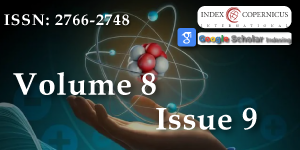Rational Unity and Total Constant A New Perspective on the Universe
Main Article Content
Abstract
The Universe consists primarily of dark energy, dark matter, and ordinary matter, the studies of recent models, such as the Big Bang and the ɅCDM, show that the fractional composition of the universe is approximately 4-5% ordinary matter, 26-27% dark matter and 67-72% dark energy. This study suggests a novel mathematical engineering model, grounded in first-principles physics, utilizing a novel mathematical tool to deliver perfect composition estimates: 5.07% ordinary matter, 26.76% dark matter, and 68.17% dark energy. These closely align with NASA's WMAP & Planck data as well as the ΛCDM model. The application of the mathematical tool enhances solutions to the Einstein equation of special relativity, and the Schwarzschild metric introduces correction factors. These aim to eliminate singularities through logic-based engineering techniques. Moreover, cosmic dynamics and black hole evolution calculate the universe's expansion speed: 0.104 of the light speed, estimates Hubble constant: ~ 71 km/s/Mpc, proposes that stars undergo 21 collapses or 7 distinct stages to become black holes, suggests the universe may currently exist as a neutron entity or a black hole, and predicts existence of 286 ancient massive entities.
Article Details
Copyright (c) 2025 Elescandarany AW.

This work is licensed under a Creative Commons Attribution 4.0 International License.
NASA. Cosmic history [Internet]. NASA Science. [cited 2025 Sep 9]. Available from: https://science.nasa.gov/Universe/overview
Hoh FC. On the Ratios Dark Matter (Energy)/Ordinary Matter ≈ 5.4 (13.6) in the Universe. J Mod Phys. 2020;11:967–75. Available from: https://www.scirp.org/journal/jmp
Spergel DN. The dark side of cosmology: Dark matter and dark energy. Science. 2015;347(6226). Available from: https://pubmed.ncbi.nlm.nih.gov/25745164/
NASA Science. Dark Energy, Dark Matter [Internet]. NASA Astrophysics; 2015 Jun 5 [cited 2025 Sep 9]. Available from: https://www.bing.com/search?q=+NASA%2C+%E2%80%9CDark+Energy%2C+Dark+Matter%E2%80%9D%2C+NASA+Science%3A+Astrophysics.+5+June+2015
NASA Science. Building Blocks [Internet]. [cited 2025 Sep 9]. Available from: https://science.nasa.gov/Universe/overview/building-blocks/
NASA. Planck Mission Brings Universe into Sharp Focus [Internet]. 2013 [cited 2025 Sep 9]. Available from: https://planck.ipac.caltech.edu/image/planck13-001b
National Radio Astronomy Observatory. The Mysterious Dark Energy [Internet]. [cited 2025 Sep 9]. Available from: https://public.nrao.edu/radio-astronomy/dark-energy/
Wikipedia. Dark matter [Internet]. [cited 2025 Sep 9]. Available from: https://en.wikipedia.org/wiki/Dark_matter
Wikipedia. Expansion of the universe [Internet]. [cited 2025 Sep 9]. Available from: https://en.wikipedia.org/wiki/Expansion_ofthe_universe
Encyclopaedia Britannica. How fast is the universe expanding? [Internet]. [cited 2025 Sep 9]. Available from: https://www.britannica.com/story/how-fast-is-the-universe-expanding
Wikipedia. Hubble's law [Internet]. [cited 2025 Sep 9]. Available from: https://en.wikipedia.org/wiki/Hubble%27s_law
Sentinel Mission. Hubble Constant (H₀) – Definition and Detailed Explanation – Astronomical Units & Measurements Glossary [Internet]. [cited 2025 Sep 9]. Available from: https://sentinelmission.org/astronomical-units-measurementsglossary/hubble-constant-h%E2%82%80/
Wikipedia. Schwarzschild radius [Internet]. [cited 2025 Sep 9]. Available from: https://en.wikipedia.org/wiki/Schwarzschild_radius
Wikipedia. Relativistic Mechanics [Internet]. [cited 2025 Sep 9]. Available from: https://en.wikipedia.org/wiki/Relativistic_mechanics
Wikipedia. The Lorentz Factor [Internet]. [cited 2025 Sep 9]. Available from: https://en.wikipedia.org/wiki/Lorentz_factor
Science Facts. Life cycle of a star: stages, facts, and diagrams [Internet]. [cited 2025 Sep 9]. Available from: https://www.sciencefacts.net/life-cycle-of-a-star.html
Wikipedia. Sun [Internet]. [cited 2025 Sep 9]. Available from: https://en.wikipedia.org/wiki/Sun
Wikipedia. List of largest stars [Internet]. [cited 2025 Sep 9]. Available from: https://en.wikipedia.org/wiki/List_of_largest_stars
Wikipedia. List of smallest known stars [Internet]. [cited 2025 Sep 9]. Available from: https://en.wikipedia.org/wiki/List_of_smallest_known_stars
Wikipedia. List of most massive neutron stars [Internet]. [cited 2025 Sep 9]. Available from: https://en.wikipedia.org/wiki/List_of_most_massive_neutron_star
Wikipedia. The Speed of light [Internet]. [cited 2025 Sep 9]. Available from: https://simple.wikipedia.org/wiki/Speed_oflight
Wikipedia. Jupiter [Internet]. [cited 2025 Sep 9]. Available from: https://simple.wikipedia.org/wiki/Jupiter
Wikipedia. Gravitational constant [Internet]. [cited 2025 Sep 9]. Available from: https://en.wikipedia.org/wiki/Gravitational_constant
Wikipedia. Antares [Internet]. [cited 2025 Sep 9]. Available from: https://en.wikipedia.org/wiki/Antares
Wikipedia. Betelgeuse [Internet]. [cited 2025 Sep 9]. Available from: https://en.wikipedia.org/wiki/Betelgeuse
Wikipedia. KW Sagittarii [Internet]. [cited 2025 Sep 9]. Available from: https://en.wikipedia.org/wiki/KW_Sagittarii
Wikipedia. Mu Cephei [Internet]. [cited 2025 Sep 9]. Available from: https://en.wikipedia.org/wiki/Mu_Cephei
Wikipedia. KY Cygni [Internet]. [cited 2025 Sep 9]. Available from: https://en.wikipedia.org/wiki/KY_Cygni
Wikipedia. V354 Cephei [Internet]. [cited 2025 Sep 9]. Available from: https://en.wikipedia.org/wiki/V354_Cephei
Wikipedia. Wolf 359 [Internet]. [cited 2025 Sep 9]. Available from: https://en.wikipedia.org/wiki/Wolf_359
Wikipedia. PSR J0952–0607 [Internet]. [cited 2025 Sep 9]. Available from: https://en.wikipedia.org/wiki/PSR_J0952%E2%80%930607
Wikipedia. PSR J0740+6620 [Internet]. [cited 2025 Sep 9]. Available from: https://en.wikipedia.org/wiki/PSR_J0740%2B6620
Wikipedia. PSR J1614–2230 [Internet]. [cited 2025 Sep 9]. Available from: https://en.wikipedia.org/wiki/PSR_J1614%E2%88%922230

